Christmas Disease — Yes, it's real, 100% scientifically proven!
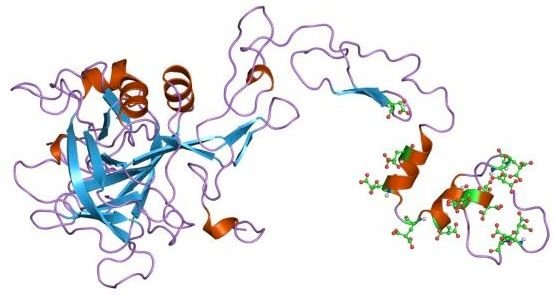
Depicted is what biologists call a Christmas factor. But even a non-biologist can see this is clearly Xmas tree decorations. Science is so easy.
Source: in Wikimedia Commons contributors
Introduction
You may think the more PC way of terming this would be "holidays disease". But the boy who was the first official carrier of this genetic affliction was Stephen Christmas, not Stephen Holiday[2].
If you don't want to call the disease after its first known sufferer, and insist on a more dogma-neutral term, you may use Hemophilia B.
(No, I did not pull a clickbait-and-switch, you're the one, dear reader, who misunderstood the title of this post! I am not to blame for your misunderstandings. Which are entirely unintentional on my part. Really.)
Jokes aside, in the festive spirit of this day, I decided to write a post about how geneticists can deduce disease from pedigrees. In lieu of Christmas trees, we will look at family trees. Diseased family trees. Only tools you'll need is certain Mendelian rules plus logic.
We will look at Christmas disease at the end of this post. Right now, let's begin by looking at a female more naked than you've ever seen before.
I AM NOT RESPONSIBLE FOR ANY HEALTH-RELATED ADVERSE EFFECTS ARISING FROM READING THIS POST.
This liability clause came out of nowhere. But it will make sense later.
Human female karyotype
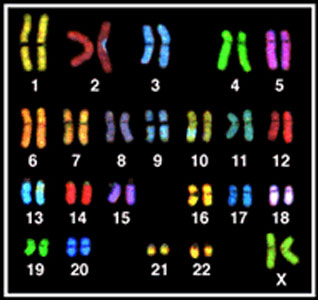
It rarely gets more up-close-and-personal than this.
Source: in Wikimedia Commons contributors, modified
Depicted are 22 autosomal chromosome pairs, and one sex chromosome, labelled by the very algebraically impersonal letter X.
The autosomal chromosomes always have an homologous pair. This chromosomal ball-and-chain codes for the same genes but not the same alleles for those genes. So they both will code for, say, hair color, but not the same hair color: one allele may code for the brunette phenotype while the other allele may code for the blond phenotype, and you will express whichever color is dominant (if the traits are highly penetrant[4], but you don't need to worry about this).
The sex chromosome determines the biological sex of the person, and is homologous only in females.
Now let's look at a male nudie pic.
Y we are males
"Why was I born a male?" Not all whys contain the answer to their own question, but this one does.
You see, Y is the reason:
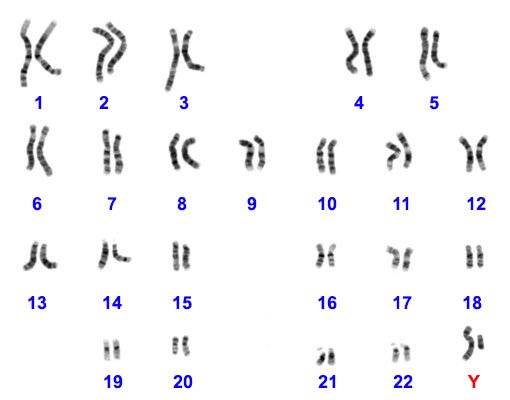
Source: in Wikimedia Commons contributors, modified
I've labelled it simply as Y to mirror the spectral pic above with the X, but strictly speaking a female has two X chromosomes and a male has one X and one Y (that's the puny little one), and this makes him a biological male.
Not that it always goes as smoothly as that: there is a thing called testicular feminization syndrome. But we'll come to that in a later section.
For now, let's check those Xmas family trees!
Deducing disease using pedigree analysis
Humans are not ideal experimental organisms. Our lifecycles are long, we don't multiply as quickly or as fruitfully as some gods would like us to (Genesis 1:28), and most of us have this notion that mating should be up to personal choice rather than decided by scientists keen on testing a hypothesis. (Humans can be irrational like that.) In other words, we are very different from peas and flies, referred to as model organisms. Nonetheless, the same Mendelian laws of inheritance apply to us.
And when scientists want to study these inheritances, they have to turn to pedigrees, due to our aforementioned limitations as study organisms.
There are four inheritances that can rather easily be deduced from pedigree patterns, and we will check these out in turn, with examples. They are autosomal recessive, autosomal dominant, X-linked dominant, and X-linked recessive.
First Example
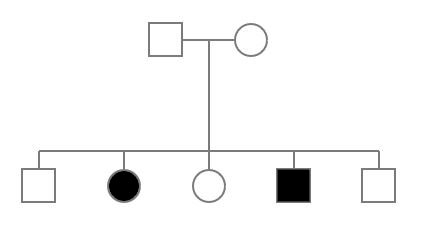
Boys are square and girls are round. Top row are parents and bottom row are children. Whites are unaffected with the disease and blacks are affected.
I know: pedigree-reading science is sexist, racist, and ageist.
Let's say a patient walks into your office, complaining about a condition. You want to find out if his condition is inherited in an autosomal or sex-linked fashion, and if it's dominant or recessive. So you ask for a pedigree, and he dutifully presents you with the above. What can you conclude from that?
You know that if a disease is autosomal (i.e. involves the autosomal, not the sex, chromosomes), it by definition affects males and females in equal measure, and the sex of the carrier parent doesn't matter either. This is consistent with the above pedigree, even though we don't see a clear 50-50 ratio of affected children because (a) the children are an odd number and (b) small numbers more easily defy the laws of statistics (a coin flip could give you tails the first 5 times you do it, but it doesn't mean the 50-50 ratio of tails vs heads is bogus).
If the disease is recessive — meaning that a normal allele (version of a gene) can "rescue" it — it only shows up if both alleles are the same. If a person is only a carrier — has both a normal and a recessive allele — they will not show the phenotype. This means that two unaffected parents may have an affected child[8]. This is clearly the case in the above pedigree.
From 2, we know that the condition is recessive. Can we rule out it's sex-linked recessive? Yes we can, because for a daughter to be affected with a recessive disorder, it would have to inherit one diseased X chromosome from her mom, and one from her dad. The mom can have one normal X chromosome and one that's diseased, so she can be unaffected because one X rescues the other X. But her dad has only one X chromosome, his Y chromosome can't rescue his X chromosome, so if he gave a diseased X chromosome to his daughter, he ought to be affected too. He isn't, so the disease is not X-linked.
The disease is not dominant, since if that was the case it would be impossible for the affected children to have unaffected parents. (If the children are affected, then the parents must carry an affected allele. If the affected allele was dominant, it would make the parents diseased.)
So the most likely scenario is that the disease is autosomal recessive.
And that's just by using some basic Mendelian principles + pure logic!
What's a real-life example of a human autosomal recessive disorder?
I believe Lord Voldemort was affected with this, but I can't be sure without looking at his pedigree.
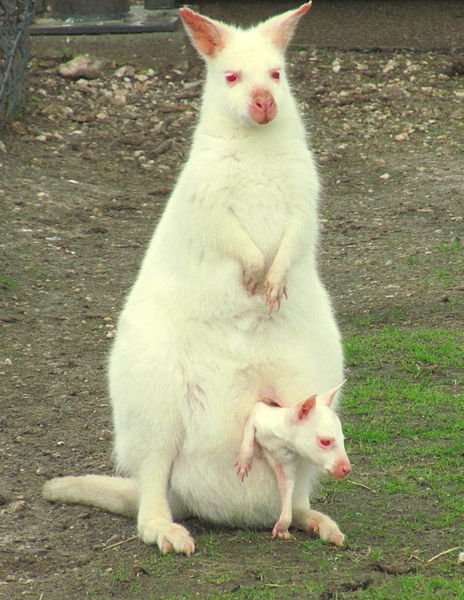
I'm so used to seeing this phenotype in mice and bunnies, that I can't see this as a wallaby. No, it's just a huge bunny to me.
Source: in Wikimedia Commons contributors
Example Deux
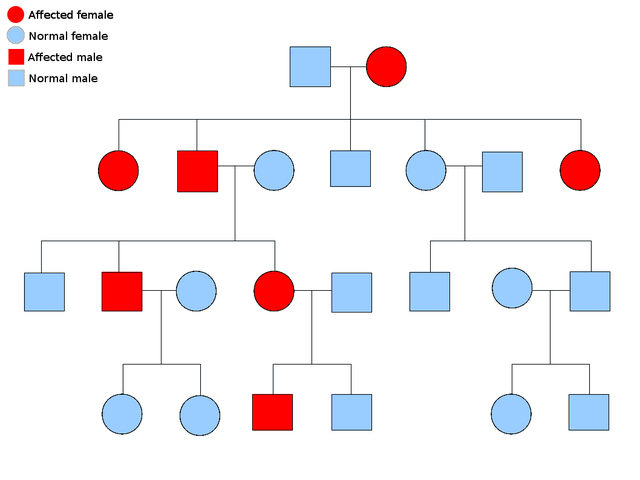
Source: in Wikimedia Commons contributors
Autosomal dominant is the easiest. One of the main clues is that it appears in every generation: since the phenotypes aren't recessive they can't "hide", they must appear every single time. And if a person doesn't exhibit the phenotype, it means he doesn't carry the allele. All the other reasonings are the same as for autosomal recessive.
A real-life human example of this is polydactyly, which according to at least one sci fi movie makes you better at playing the piano.
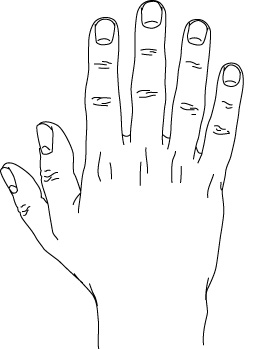
This guy's all thumbs.
Source: Wikimedia Commons contributors
Example the Third
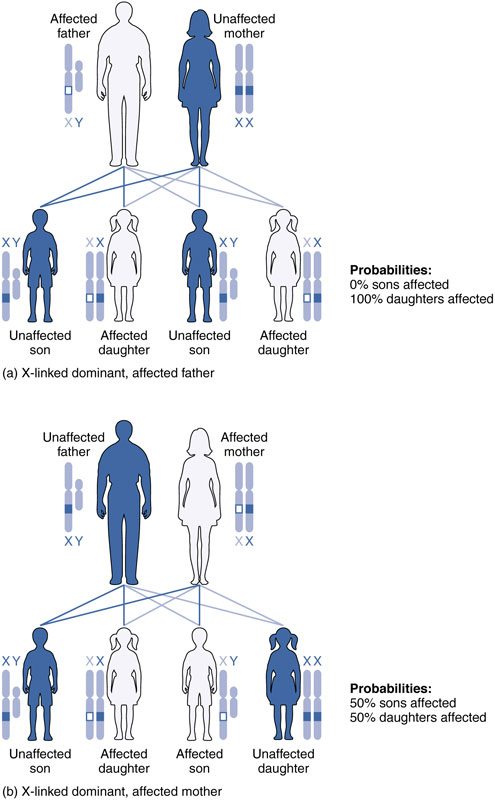
Source: Wikimedia Commons contributors
X-linked dominant is easy. There are two rules:
- Affected males pass the condition to all their daughters but to none of their sons. [...] 2. Affected heterozygous females married to unaffected males pass the condition to half their sons and daughters [8]
Reason for rule 1 is that males must get their dad's Y (in order to be males), and one of mom's Xs. So they can't get their dad's X, so they can't get his X-linked dominant disease. And rule 2 also follows from Mendelian genetics.
X-linked dominant is rare in humans. Wikipedia only lists 7 X-linked dominant human diseases, and two of these don't even have their own wikipedia article, and all of which I've never heard of.
Example numero quattro
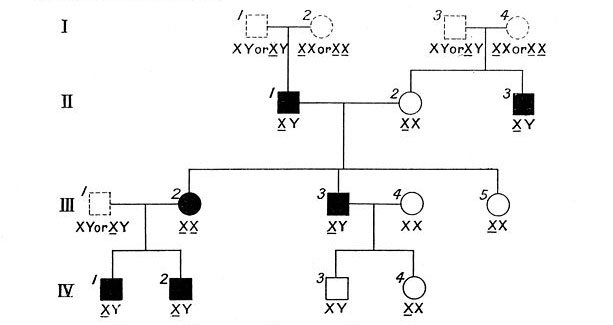
Source: Wikimedia Commons contributors
Both autosomal recessive and autosomal dominant affect equal numbers of males and females. When there are disproportionately affected males, like in the pedigree above, think X-linked.
Is it X-linked dominant? No, because female 5 from generation III is not affected, and she must get one X chromosome from dad, who's only got one to offer, and who is affected. So if the disease was dominant, she would be affected too.
Another tell-tale sign of X-linked recessive is that many more males than females are affected. The reason is because males only have to inherit one bad X chromosome to be affected, since they got no second X to rescue them, but females have to inherit both.
So the above is clearly an example of an X-linked recessive pedigree.
If fact, it's a pedigree of red-green colorblindness. People with this condition can't distinguish red from green. There are easy tests for this condition. The picture below shows one red Christmas present and one green. If you see them as being the same color, it means you are red-green colorblind.

Color blindness test. Do you see these gift boxes as the same color?
Source: Pixabay
I kid. Both boxes are red. Hopefully no one's had a heart attack. Is it too late to do an exclusion of liability clause? Let me scroll up and add it somewhere.
Another example, one I promised I'd come back to, is testicular feminization syndrome. People who have this are chromosomally male but develop as females, female genitalia and all; they often marry, but can't procreate[8].
Christmas disease

Queen Victoria, also known as "mosquito heaven" and "zombie bait", though I've no references for that.
Source: Wikimedia Commons contributors
Finally, Xmas disease!
Christmas disease is actually an example of X-linked recessive, just like color-blindness and testicular feminization syndrome. (I know, X-linked recessive got all the cool ones!)
I jumped to the punch line in the introduction: Christmas disease is actually hemophilia B, named Christmas disease after the first known human case. Hemophilia, if you didn't know, is when blood fails to clot. Think of it as a straw that a Vampire doesn't even need to suck. Just insert his fangs and the blood will flow and never stop.
Good news is, if you have hemophilia, you might be royalty: due to its preponderance in European royal families, it's popularly known as "the royal disease"[10]. Queen Victoria is often considered to be patient zero. But to hemophiliacs, she may simply be "nana".
Curtain close
Geneticists can use pedigrees to track down diseases, either into the past, or into the future, and warn parents about afflictions their children might inherit, and the probabilities that they will inherit it, even if the parents themselves are unaffected. Many diseases are treatable or manageable if detected early, and pedigree analysis is one of the few ways in which diseases can be detected before the children are even conceived.
It's amazing that you can do these things, and many more, with some simple first principles and deduction. After all, Mendel's approach was mathematical, and where there's math, there's deduction. Though human genetics is hard, because you can't breed humans at will (and even if you do, you'll have to wait a long time for your efforts to bear fruit), still some of Mendel's rules are so clean-cut as to be plug-and-play. As in many other things, so in pedigrees, Mendel's work stands the test of time.
Now let's spruce up an Xmas tree with some Xmas factor! Happy disease-free holidays people!
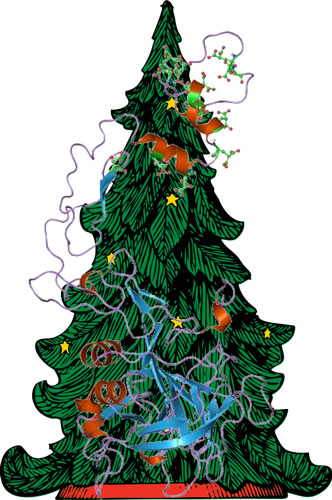
Christmas tree as decorated by a biologist.
Source: Freestockphotos & Wikimedia Commons contributors, modified
References
1. Wikipedia contributors, "Factor IX," Wikipedia, The Free Encyclopedia, https://en.wikipedia.org/w/index.php?title=Factor_IX&oldid=798130641 (accessed December 24, 2017).
2. Wikipedia contributors, "Stephen Christmas," Wikipedia, The Free Encyclopedia, https://en.wikipedia.org/w/index.php?title=Stephen_Christmas&oldid=816375312 (accessed December 24, 2017).
3. Wikipedia contributors, "Haemophilia B," Wikipedia, The Free Encyclopedia, https://en.wikipedia.org/w/index.php?title=Haemophilia_B&oldid=794999733 (accessed December 24, 2017).
4. Griffiths AJF, Miller JH, Suzuki DT, et al. An Introduction to Genetic Analysis. 7th edition. New York: W. H. Freeman; 2000. Penetrance and expressivity. Available from: https://www.ncbi.nlm.nih.gov/books/NBK22090/
5. Wikipedia contributors, "Karyotype," Wikipedia, The Free Encyclopedia, https://en.wikipedia.org/w/index.php?title=Karyotype&oldid=816861010 (accessed December 24, 2017).
6. OpenStax, Biology. OpenStax CNX. Dec 19, 2017 http://cnx.org/contents/[email protected].
7. What are model organisms? https://www.yourgenome.org/facts/what-are-model-organisms
8. Griffiths AJF, Miller JH, Suzuki DT, et al. An Introduction to Genetic Analysis. 7th edition. New York: W. H. Freeman; 2000. Human genetics. Available from: https://www.ncbi.nlm.nih.gov/books/NBK21977/
9. Wikipedia contributors, "X-linked dominant inheritance," Wikipedia, The Free Encyclopedia, https://en.wikipedia.org/w/index.php?title=X-linked_dominant_inheritance&oldid=802249752 (accessed December 24, 2017).
10. Wikipedia contributors, "Haemophilia in European royalty," Wikipedia, The Free Encyclopedia, https://en.wikipedia.org/w/index.php?title=Haemophilia_in_European_royalty&oldid=815287330 (accessed December 24, 2017).
Earlier Introduction to Biology episodes:
6: The Most Famous All-Nighter in the History of Genetics
5: Mendel's Lucky Number Seven — The law of genetics that almost wasn't
4: How Cells Use Logic To Do The Impossible
3 : Armchair Science — The Discovery of Proteins' Secondary Structure
2 : How Cell Membranes Form Spontaneously
1 : Eduard Buchner: The Man Who Killed Vitalism
steemSTEM is the go-to place for science on Steemit. Check it out at @steemstem or browse the #steemSTEM tag or chat live at steemit.chat
You referencing genesis made me laugh so hard :D! Oh, and ... the vampire example is really creepy :)
Great post! Merry Christmas to you.
Thanks Abigail! Merry holidays to you too! :D
I want an albino kangaroo for Christmas!
Don't we all!
Strasdwudi!
I must abuse your post in order to give you the note, that I nominated you for the black & white challenge :-)) I know that you were just waiting for someone coming around this corner.
Curious, how you are going to take the challenge!
I say "spasiba" in advance "my Russian" connection:)
P.S. congrats to this article and the high upvote! I will read it later, I promise!
Edit: You almost got me with the red green color test! I was a little frozen and then quickly continued reading. You rascal! :-) This little humor of you sparkled here and there is indeed very entertaining. Excellent work of yours.
I must myself write another article. Though I am so busy with family that I hardly get any breaks. But I don't want to complain. I love to stay with my brothers & sister.
Damn, I have to come up with ideas now! p
Your Russian sounds so much like German! On the other hard, the Russians did borrow many words from German, and zdrastvyit'e sounds very much like one!
I'm very happy my color test worked! I wondered if anyone would fall for it, at least for a second, like do a double-take and say "huh!?", and feel their heart skip a beat, a sudden small panic! 😄
Yeah I promised myself to write one science article a week, and every time the deadline nears I have to make time for it which isn't always easy, especially now, so I feel you!
I was lucky with this one, I was trying to think, is there anything Christmas-related in introductory biology that jibes with the previous stuff I wrote? And suddenly Christmas disease just came to me, and the whole article sort of popped up in my awareness. I wonder if there's anything New-year-related! New Year's disease? Doesn't ring a bell.
Many spacibos for the nomination and for reading the whole thing, I suspect not many do!
Happy holidays and family-times to you and hope your article-writing will be swift and not take a lot of your time!
Now I must get to work on that B&W thing, which I suspect is a 'get SBD quick scheme'. Hmm..
That's exactly what happened: I was looking at two RED parcels and thought: "Huh"??? And then this thought popped into my mind like: "I was never aware of that... " and then I thought "... No, wait, just go on reading" :-)) You did a good job on that!
Yes, I am having the same goal with Steemstem articles. But I am afraid this week I won't have enough concentration here in the lap of my family. Let's see - hehe, "New Years disease" does not sound very sexy. LOL. I am sure you are going to find a much better topic.
Yes, my Russian is German. HaHa!!
Have fun with your motives for the challenge. It is more joy than I would have expected. No easy SBD - at least not for me but that it's not what it is about, I guess.
I was re-looking at my introduceyourself post 6 months ago when you commented and decided to visit you to see what you've been up to..
Wow... what quality content you produce. I'm impressed.
You said then:
I'd like to re-iterate the same thing to you:
The merit of your work stands on it's own.
Great job here. Very interesting analysis. You're an asset to STEEM.
Thanks a lot man!
I hate to disappoint though: that comment isn't mine! I did reply to that comment, cos I was impressed myself. And I did make a comment to the post itself too, but it was very much your run-of-the-mill comment, nothing like the eloquent thing you misattributed to me!
I do remember your post vividly for some reason, maybe because of its content, maybe because I only joined about 6 months ago, so maybe it was one of the first I read.
Or maybe cos I watched The Knick because of it!
Hopefully the compliment still stands, despite all that!
Sincerely, this is highly educating and interesting to read. Your examples and illustrations made me read to the end. Merry Christmas
Great post! Great to see someone referencing properly!
Christmas disease...!!! Amazing post my dear friend.
@OriginalWorks
The @OriginalWorks bot has determined this post by @alexander.alexis to be original material and upvoted it!
To call @OriginalWorks, simply reply to any post with @originalworks or !originalworks in your message!
What a appreciate post
Wow....awww....